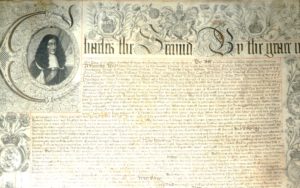Barrington and the Dorr Rebellion of 1842
By Luther Spoehr
BPS Board Member
Senior Lecturer Emeritus, Brown University
“In Barrington, as well as throughout the state, the excitement was intense, and personal hatred was bitter between members of the two parties. Family ties were broken by the strains of partisanship. Personal danger, more real than fancied, led many Dorrites of Barrington to secrete themselves or flee from the town.”
–Thomas Bicknell, A History of the Town of Barrington (1898)
It’s a complicated narrative. To keep track of it all, you need to know that in 1842 Rhode Island’s Constitution was the ancient Royal Charter of 1663. Although, when issued, it had provided for the most liberal suffrage in the colonies, by the 1820s its property and other requirements for voting were the most restrictive in the United States. The controversy that came to a boil in the 1842 pitted “Dorrites” (named for reformer Thomas Dorr) and their “People’s Constitution” against the “Charterites” (led by the aptly named Governor King) and their “Landholders Constitution,” which retained suffrage restrictions. For a few months, Rhode Island had two constitutions and two rival governments. The resulting military, political, and constitutional confrontations had national reverberations. 
Royal Charter of 1663 – Click here for an annotated copy of the full text.
This essay, prompted by the recent restoration of Barrington’s militia flag, presents a brief summary of Barringtonians’ participation in that conflict and an explanation of the historical contexts—national, state, and local–that help to explain the significance of this unique event and the people and events that surrounded it.
Contents
- The United States in 1840
- Rhode Island in 1840
- Barrington in 1840
- The Dorr Rebellion
- Barrington in the Dorr Rebellion
- The Dorr Rebellion and the Supreme Court: Luther v. Borden (1849)
- Militias, the Barrington Militia, and Their Flag
Appendix I: Officers and Men of the [Anti-Dorr] Barrington Militia
